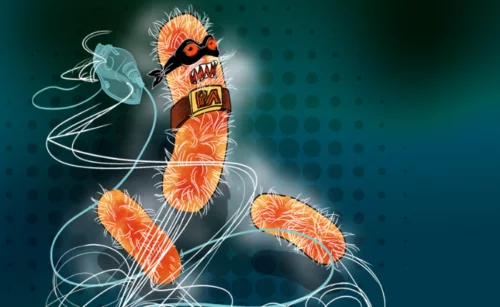Meet Neisseria gonorrhoeae
What is it?
Neisseria gonorrhoeae, the bacterium that causes the sexually transmitted infection (STI) gonorrhoea, has the ability to become resistant to antibiotics quickly, making it a growing public health concern. Drug-resistant N. gonorrhoeae infections are more difficult to treat, which has contributed to recent spikes of gonorrhoea infections. That is because infections can last longer, increasing the chances of more people becoming infected. Currently more than 82 million people are newly infected with gonorrhoea every year.
Women infected with N. gonorrhoeae often don’t notice any symptoms, while men can experience genital pain and penile discharge. If gonorrhoea isn’t treated, it can cause serious complications, including infertility and ectopic pregnancies in women, and sterility in men. The social stigma around gonorrhea infection can also harm personal relationships and quality of life.
How is it spread?
N. gonorrhoeae spreads through vaginal, oral or anal sex. Gonorrhoea can also be passed during birth from an infected mother to her newborn baby, potentially causing severe neonatal eye infections that can result in blindness. Drug-resistant N. gonorrhoeae is highest among certain groups, like men who have sex with men and sex workers, as well as young people and over 50s in countries where infection rates are high.
N. gonorrhoeae bacteria have hair-like proteins on their surface, known as pili, that help them infect humans by attaching to and moving along surfaces. This is one way in which they can escape our immune systems by frequently changing the makeup of these pili, making it hard for antibodies to recognize and attack them.

Where is it found?
N. gonorrhoeae’s resistance to penicillin was first detected as early as the 1940s, soon after the drug began to be used for treatment. Over the past 85 years, N. gonorrhoeae has developed resistance to almost all types of antibiotics used to treat it. N. gonorrhoeae ‘superbugs’ with resistance to the class of antibiotics known as cephalosporins – our last line of defense – have already been detected in Japan, Australia and Europe. This has raised concerns that we are quickly running out of options to manage the disease.
Drug resistance
N. gonorrhoeae has acquired different ways to resist the drugs that are used to treat it. Like all Gram-negative bacteria, the outside part of the cell has a pump that expels drugs back out of the cell; this makes it difficult for antibiotics to stay inside the cell and kill the bacterium. Also, by making continuous changes to the structure of proteins on its surface, it is able to hide from antibodies that attempt to attach to it. It can also produce enzymes that destroy certain antibiotics.
N. gonorrhoeae is skilled at picking up genetic material (DNA) from neighbouring cells including related but harmless Neisseria species, a process known as “transformation”. This allows it to gather antibiotic resistance genes from other bacteria. As a result, once resistance to a particular antibiotic develops in other species, N. gonorrhoeae can acquire it rapidly. This makes it especially important to protect new antibiotics from resistance by making sure they are only used when needed.


